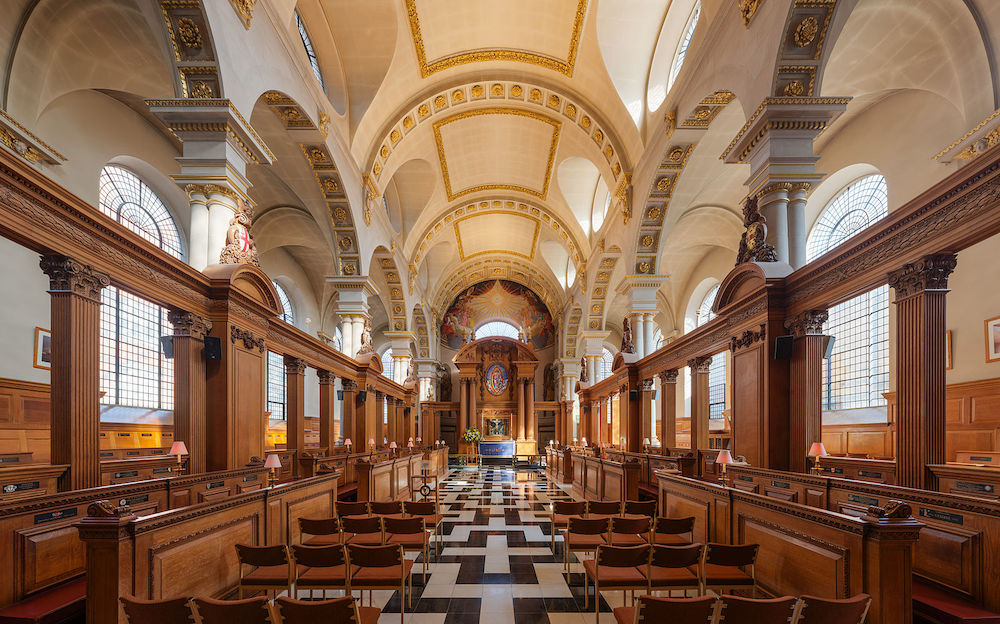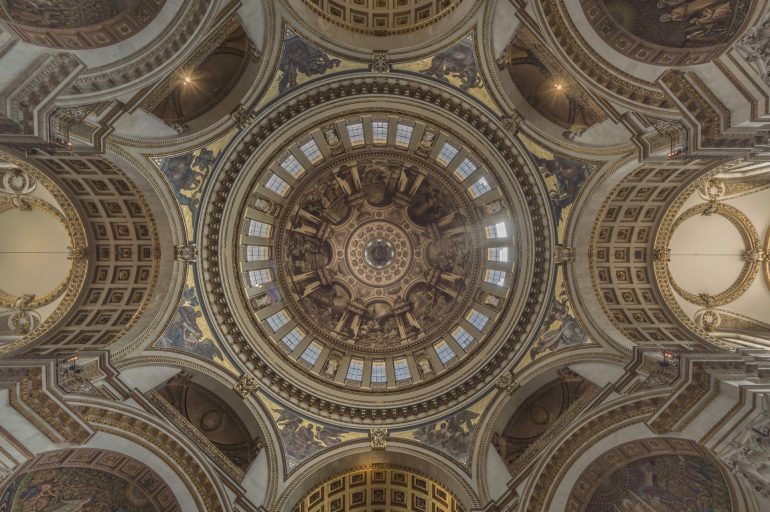Christopher Wren is undoubtedly London’s greatest architect. He rebuilt London and its great cathedral, Saint Paul’s, after the Great Fire in 1666, which burned down much of the old city. Yet, you will never see a statue, monument, or even a memorial plaque to him anywhere in the capital. Why? Because his epitaph at Saint Paul’s Cathedral says, ‘Lector, si monumentum requiris, circumspice.’ Translated from the original Latin, this means, ‘Reader if you wish to see his memorial, look around you.’ It is a wonderful epitaph for an architect: just look at what he created for his memorial.
Whereas our national church Westminster Abbey was built by a variety of men, many unknown, over its long history, Saint Paul’s Cathedral has just one architect – Christopher Wren. He also rebuilt over fifty churches in London after the Great Fire as well as Chelsea Royal Hospital, the old soldiers’ home in Chelsea where a famous Flower Show takes place every summer and where Margaret Thatcher and her husband Denis, who were great supporters of the hospital, are buried. Wren also designed a home for retired sailors in Greenwich, which is now a university and museum, and Saint Peter’s chapel where they could worship. He worked on both Kensington and Hampton Court Palaces, two royal homes further from the polluted air of central London, which William the Third (of William and Mary fame) disliked so much and which was bad for his asthma.
 St Paul’s Cathedral in London. Photo Credit: © Ursula Petula Barzey.
St Paul’s Cathedral in London. Photo Credit: © Ursula Petula Barzey.
Christopher Wren was not trained as an architect but as a scientist and had his education at Westminster School in London and at Oxford University. He became a Professor of Astronomy at Gresham University at the age of twenty-five and the Savilian Professor of Astronomy at Oxford five years later. He was also a founder of the Royal Society, a group of men who met to discuss scientific and intellectual matters, and he served as its president from 1680 to 1682. Wren was knighted in 1673 and was also a Member of Parliament on four occasions.
One of Christopher Wren’s closest friends and colleagues was Robert Hooke, who was also a distinguished scientist and part-time architect. A picture emerges of Wren as a man with an enquiring mind who trained and worked as a scientist but became a famous architect because London needed rebuilding after the fire in September 1666 gave him his chance.
Despite his interest in science, Wren came from a religious background – there was little conflict between the two in the seventeenth century. He was born in East Knoyle in Wiltshire, and his father was later appointed as Dean of Windsor. (You can see his name in the list of deans in Saint George’s Chapel inside the castle.) The close connection of the Wrens with the royal family meant that they had to remain discreet while England was ruled as a republic by Oliver Cromwell in the 1650s until the monarchy was restored in 1660 under King Charles the Second, who later granted a royal warrant to the Royal Society.
 Sir Christopher Wren painting by Godfrey Kneller. Photo Credit: © Public Domain via Wikimedia Commons.
Sir Christopher Wren painting by Godfrey Kneller. Photo Credit: © Public Domain via Wikimedia Commons.
Sir Christopher Wren married twice, but neither marriage lasted long, and both his wives died after a few years. His first marriage, to Faith Coghill, produced two sons, one who died young and a younger Christopher who also worked as an architect, composed his father’s epitaph, and wrote a memoir of the family. Wren’s second marriage, to Jane Fitzwilliam, produced a much-loved daughter, also called Jane after her mother, as well as a son, ‘poor Billy,’ who was probably developmentally retarded. He remained a widower after the death of his second wife. A small bird-like man, Wren endured a sickly childhood but lived to the age of ninety, often going into Saint Paul’s in his later years to see how work on the great cathedral was progressing. It was in the crypt of St Paul’s Cathedral that Wren was laid to rest when he died in 1723.
A legend has it that Wren’s daughter Jane showed how much she trusted her father by sitting under the spire of Saint Dunstan’s in the East church near London Bridge. The church had been badly damaged during the Great Fire, and Wren agreed to rebuild it while at the same time maintaining its gothic character. Some of the parishioners thought that the gothic style of the spire he designed would not be strong enough, so Wren asked Jane to sit underneath to show the world that it would not collapse. The spire still stands where Wren built it, although the church is no longer in use and is now a garden for city workers.
 Top of St Dunstan-in-the-East church designed by Sir Christopher Wren. Photo Credit: © Edwin Lerner.
Top of St Dunstan-in-the-East church designed by Sir Christopher Wren. Photo Credit: © Edwin Lerner.
Another famous church designed by Christopher Wren is Saint Bride’s in Fleet Street, which is sometimes referred to as ‘the wedding cake church’ because of the shape of its spire. Saint Bride’s is connected with the newspaper industry, and it was here that Rupert Murdoch was married to Jerry Hall, the former wife of Mick Jagger of the Rolling Stones. This was his fourth marriage and her second, but it did not last, and they later separated.
Christopher Wren’s only church in the west end of London is Saint James’s, Piccadilly, which stands near the famous shop Fortnum and Mason. It was here that the poet and painter William Blake was baptised, even though his family were dissenters and did not abide by the rules of the Church of England. Blake’s father probably thought that paying lip service to the Anglican church was necessary for his business as a cloth merchant to survive. The church is famous for music and often hosts choirs visiting Britain from around the world. The spire, having been bombed in the blitz, is made from plastic but follows Wren’s original design.
 Interior of St Bride’s Church designed by Sir Christopher Wren. Photo Credit: © Diliff via Wikimedia Commons.
Interior of St Bride’s Church designed by Sir Christopher Wren. Photo Credit: © Diliff via Wikimedia Commons.
As an architect, Christopher Wren was used to getting his own way, although he also relied a great deal on the team who worked with him on the massive job of rebuilding London after the Great Fire. They included his assistant architect, Nicholas Hawksmoor, and another architect John Vanburgh, who was also a successful playwright. Wren’s woodcarver was called Grinling Gibbons, and you can see his beautiful carvings in many churches and other buildings designed by Wren. His painter was James Thornhill, father-in-law to another painter William Hogarth. Thornhill painted the scenes from the Life of Saint Paul under the cathedral dome.
Near the dome is the high altar of the cathedral, which is dedicated to the men and women of the Commonwealth who gave their lives during the Second World War. Behind the altar is the American Chapel, rebuilt after this part of the church was damaged by bombing in the war. Above the altar stands a canopy or baldacchino which closely follows the designs of Christopher Wren, even though the city fathers felt that they could not afford to build it to his design during his lifetime. However, his wishes were realised 200 years after his death.

View of the Dome ceiling within St Paul’s Cathedral. Photo credit: © Graham Lacdao, St Paul’s Cathedral.
Another story connected with Christopher Wren is that of the columns at Windsor Town Hall. The townspeople thought that the canopy he had designed to stand in front of the hall needed some extra supporting columns and insisted that he had them built. Wren said that they were not needed but installed them anyway. However, he proved his point by having the columns built so that they remained an inch or two below the ceiling they were supposed to support, thus showing that they had never been necessary in the first place. Many guides taking groups to Windsor will point these out to their clients before entering the castle.
All London Blue Badge Tourist Guides are qualified and permitted to conduct tours of Saint Paul’s Cathedral and Westminster Abbey. They also often take groups to Hampton Court Palace, Kensington Palace, and to Greenwich, where Wren’s home for retired sailors is located.
 View of the Greenwich Park, Old Royal Naval College, and Canary Wharf from the Royal Observatory Greenwich. Photo Credit: © Ursula Petula Barzey.
View of the Greenwich Park, Old Royal Naval College, and Canary Wharf from the Royal Observatory Greenwich. Photo Credit: © Ursula Petula Barzey.







Leave a Reply